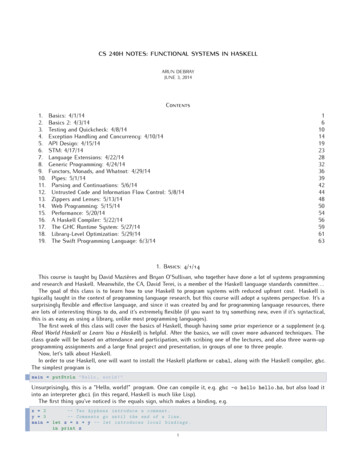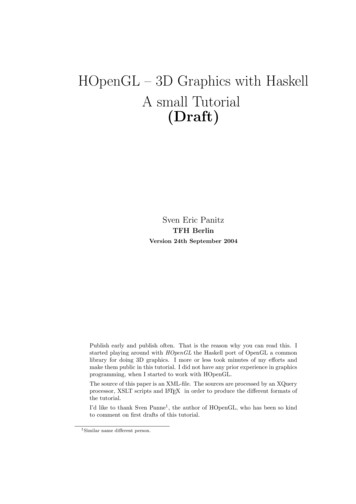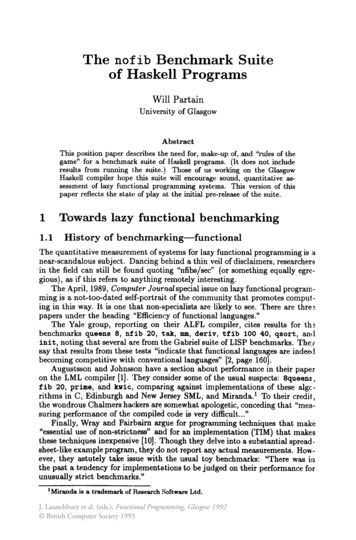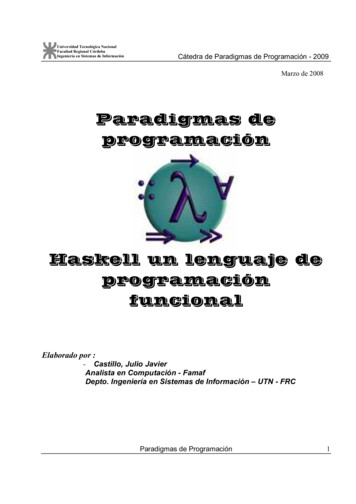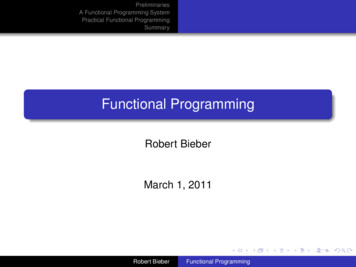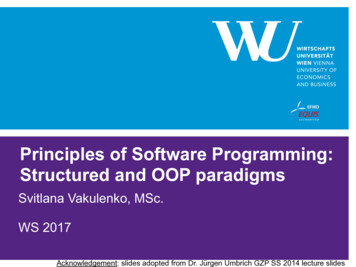
Transcription
Introduction to FunctionalProgrammingSlides by Koen Claessen and Emil Axelsson
Goal of the Course Start from the basics Learn to write small-to-medium sizedprograms in Haskell Introduce basic concepts of computerscience
The FlowYou preparein advanceDo not breakthe flow!I explainin lectureTuesdays, FridaysYou learnwith exercisesMonday afterYou put to practicewith lab assignmentsSubmit Wednesday after
Course HomepageThe course homepage will have all up-to-dateinformation relevant for the course–––––Schedule and slidesLab assignmentsExercisesLast-minute changes(etc.)Or go via thestudent /
Exercise Sessions Mondays– Group rooms Come prepared Work on exercises together Discuss and get help from tutor– Personal help Make sure you understand this week’s thingsbefore you leave
Lab Assignments General DA555/labs.html Start working on lab immediately when you haveunderstood the matter Submit each Wednesday(except in study week 1)
Getting Help Weekly group sessions– Personal help to understand material Lab supervision– Specific questions about programmingassignment at hand Discussion forum– General questions, worries, discussions– Finding lab partners
Assessment Written exam (4.5 credits)– Consists of small programming problems tosolve on paper– You need Haskell “in your fingers” Course work (3 credits)– Complete all labs successfully
A Risk 8 weeks is a short time to learn programming So the course is fast paced– Each week we learn a lot– Catching up again is hard So do keep up!––––Read the material for each weekMake sure you can solve the problemsGo to the weekly exercise sessionsFrom the beginning
LecturesYou are welcome to bring your laptopsand/or smart phones to the lectures– Use laptop to follow my live coding– Use smart phone to take part in quizzes. but this is completely optional!
SoftwareSoftware Programs Data
Software Programs Data Data is any kind of storable information, e.g:– numbers, letters, email messages– maps, video clips– mouse clicks, programs Programs compute new data from old data:– A computer game computes a sequence of screenimages from a sequence of mouse clicks– vasttrafik.se computes an optimal route given asource and destination bus stop
Programming Languages Programs are written in programminglanguages There are hundreds of different programminglanguages, each with their strengths andweaknesses A large system will often contain componentsin many different languages
Two major paradigmsImperative programming: Instructions are used to change the computer'sstate:– x : x 1– deleteFile(”slides.pdf”) Run the program by following the instructions topdownFunctional programming: Functions are used to declare dependenciesbetween data values:– y f(x) Dependencies drive evaluation
Two major paradigmsImperative programming: Instructions are used to change the computer'sstate:– x : x 1– deleteFile(”slides.pdf”) Run the program by following the instructions topdownFunctional programming: Functions are used to declare dependenciesbetween data values:– y f(x) Dependencies drive evaluation
Functional Programming Functions are used to declare dependenciesbetween data values:– y f(x) Functions are the basic building blocks ofprograms Functions are used to compose functions intolarger functions In a (pure) function, the result depends only onthe argument (no external communication)
Industrial Uses of FunctionalLanguagesIntel (microprocessor verification)Hewlett Packard (telecom eventcorrelation)Hafnium (automatictransformation tools)Shop.com (e-commerce)Ericsson (telecommunications)Motorola (test generation)Jeppesen (air-crew scheduling)Thompson (radar tracking)Facebook (chat engine)Microsoft (F#)Credit Suisse (finance)Jasper (hardware verification)Barclays Capital (finance)And many more!
Teaching ProgrammingWe want to give you a broad basis––––Easy to learn more programming languagesEasy to adapt to new programming languagesAppreciate differences between languagesBecome a better programmer!This course uses the functional languageHaskell– http://haskell.org/
Why Haskell? Haskell is a very high-level language– Lets you focus on the important aspects of programming Haskell is expressive and concise– Can achieve a lot with a little effort Haskell is good at handling complex data and combiningcomponents Haskell is defining the state of the art in programminglanguage development Haskell is not a particularly high-performance language– Prioritizes programmer-time over computer-time
Why Haskell?To get a feeling for the maturity of Haskelland its ecosystem, check out: State of the Haskell ecosystem – August 2015
Haskell programming:Cases and recursion
Example: The squaring function Given x, compute x2-- sq x returns the square of xsq :: Integer - Integersq x x * x
Evaluating Functions To evaluate sq 5:– Use the definition—substitute 5 for xthroughout sq 5 5 * 5– Continue evaluating expressions sq 5 25 Just like working out mathematics on papersq x x * x
Example: Absolute Value Find the absolute value of a number-- absolute x returns the absolute value of xabsolute :: Integer - Integerabsolute x undefined
Example: Absolute Value Find the absolute value of a numberPrograms must often Two cases!– If x is positive, result is x– If x is negative, result is -xchoose betweenalternatives-- absolute x returns the absolute value of xabsolute :: Integer - IntegerThink of the cases!These are guardsabsolute x x 0 undefinedabsolute x x 0 undefined
Example: Absolute Value Find the absolute value of a number Two cases!– If x is positive, result is x– If x is negative, result is -x-- absolute x returns the absolute value of xabsolute :: Integer - IntegerFill in the result inabsolute x x 0 xeach caseabsolute x x 0 -x
Example: Absolute Value Find the absolute value of a number Correct the code-- absolute x returns the absolute value of xabsolute :: Integer - Integer is greater thanabsolute x x 0 xor equal, absolute x x 0 -x
Evaluating Guards Evaluate absolute (-5)– We have two equations to use!– Substitute absolute (-5) -5 0 -5 absolute (-5) -5 0 -(-5)absolute x x 0 xabsolute x x 0 -x
Evaluating Guards Evaluate absolute (-5)– We have two equations to use!– Evaluate the guards absolute (-5) False -5 absolute (-5) True -(-5)absolute x x 0 xabsolute x x 0 -xDiscard thisequationKeep this one
Evaluating Guards Evaluate absolute (-5)– We have two equations to use!– Erase the True guard absolute (-5) -(-5)absolute x x 0 xabsolute x x 0 -x
Evaluating Guards Evaluate absolute (-5)– We have two equations to use!– Compute the result absolute (-5) 5absolute x x 0 xabsolute x x 0 -x
Notation We can abbreviate repeated left hand sidesabsolute x x 0 xabsolute x x 0 -xabsolute x x 0 x x 0 -x Haskell also has if then elseabsolute x if x 0 then x else -x
Boolean values False and True are values of type Bool:False :: BoolTrue :: Bool Examples:even :: Integer - Bool( ) :: Integer - Integer - Bool
Boolean values False and True are values of type Bool:False :: BoolTrue :: Bool Examples:The actual types are moregeneral – work for any“integral” or “ordered” typeseven :: Integral a a - Bool( ) :: Ord a a - a - Bool
Example: Computing Powers Compute(without using built-in x n)
Example: Computing Powers Compute(without using built-in x n) Name the functionpower
Example: Computing Powers Compute(without using built-in x n) Name the inputspower x n undefined
Example: Computing Powers Compute(without using built-in x n) Write a comment-- power x n returns x to the power npower x n undefined
Example: Computing Powers Compute(without using built-in x n) Write a type signature-- power x n returns x to the power npower :: Integer - Integer - Integerpower x n undefined
How to Compute power? We cannot write– power x n x * * xn times
A Table of Powersnpower x n011x2x·x3x·x·xxn x · x(n-1) Each row is x times the previous one Define (power x n) to compute the nth row
A Definition?power x n x * power x (n-1) Testing:Main power 2 2ERROR - stack overflowWhy?
A Definition?power x n n 0 x * power x (n-1) Testing:Main power 2 2Program error: pattern match failure: power 2 0
A Definition?First row ofthe tablepower x 0 1power x n n 0 x * power x (n-1) Testing:Main power 2 24The BASE CASE
Recursion First example of a recursive function– Defined in terms of itself!power x 0 1power x n n 0 x * power x (n-1) Why does it work? Calculate:– power 2 2 2 * power 2 1– power 2 1 2 * power 2 0– power 2 0 1
Recursion First example of a recursive function– Defined in terms of itself!power x 0 1power x n n 0 x * power x (n-1) Why does it work? Calculate:– power 2 2 2 * power 2 1– power 2 1 2 * 1– power 2 0 1
Recursion First example of a recursive function– Defined in terms of itself!power x 0 1power x n n 0 x * power x (n-1) Why does it work? Calculate:– power 2 2 2 * 2– power 2 1 2 * 1– power 2 0 1No circularity!
Recursion First example of a recursive function– Defined in terms of itself!power x 0 1power x n n 0 x * power x (n-1) Why does it work? Calculate:– power 2 2 2 * power 2 1– power 2 1 2 * power 2 0– power 2 0 1The STACK
Recursion Reduce a problem (e.g. power x n) to asmaller problem of the same kind So that we eventually reach a “smallest” basecase Solve base case separately Build up solutions from smaller solutionsPowerful problem solving strategyin any programming language!
Counting the regions n lines. How many regions?remove oneline .problem iseasier!when dowe stop?
Counting the regions The nth line creates n new regions
A Solution Don't forget a base caseregions :: Integer - Integerregions 1 2regions n n 1 regions (n-1) n
A Better Solution Always make the base case as simple aspossible!regions :: Integer - Integerregions 1 2regions n n 1 regions (n-1) nregions :: Integer - Integerregions 0 1regions n n 0 regions (n-1) n
Important data structure: lists Example: [1,2,3,4] Types:– [1,2,3]– [True, False]– [[1,2,3],[4,5,6]]:: [Integer]:: [Bool]:: [[Integer]] Strings are lists– “Haskell”:: String– “Haskell”:: [Char]– ['H', 'a', 's', 'k', 'e', 'l', 'l'] :: String More in coming lectures For now: Read section 2.3 in LYAH
Material Book (online):http://learnyouahaskell.com/ Lecture slides Overview for each 55/lectures.html
MaterialI may not have time to covereverything in each lecture.You are expected to read the rest onyour own! Overview for each 55/lectures.html
- A computer game computes a sequence of screen images from a sequence of mouse clicks - vasttrafik.se computes an optimal route given a . Haskell is defining the state of the art in programming language development Haskell is not a particularly high-performance language - Prioritizes programmer-time over computer-time.


